Tell us about yourself
I’m 48 years old, a wife, mum of 2 teenagers and a dog, and I live in Brisbane. I have a number of conditions which are part of my disability including Functional Neurological Disorder (FND), Fibromyalgia, Osteoarthritis, and CREST Scleroderma.
What has been your journey of disability?
Around 7 years ago I went to my doctor as I was having issues with my fingers, especially in winter as they would go extremely white and cold, and they became very painful as well. I was referred to my rheumatologist who diagnosed this issue as Reynaud’s Phenomenon which is also part of my autoimmune condition CREST Scleroderma which he also diagnosed.
Along with this, the rheumatologist also diagnosed me with Fibromyalgia which is a chronic pain condition, and this diagnosis made a lot of sense to me as it answered a lot of questions in regards to the pain and fatigue I had been experiencing for years.
Multiple scans over the years have found that I have bad osteoarthritis in my lower back, both feet and in many other parts, which cause chronic pain and can also affect my walk/gait.
In April 2024 I was diagnosed by my neurologist with Functional Neurological Disorder, which again answered a lot of questions I had, as MRIs had cleared me of any damage to the brain but I was having a lot of neurological problems including really bad foot drop and leg tremors particularly in my right leg which was making my walking even harder than it was before. Plus, there was other signs leading to FND but as these symptoms also are similar to Fibromyalgia symptoms, my FND diagnosis took some time to get confirmation.
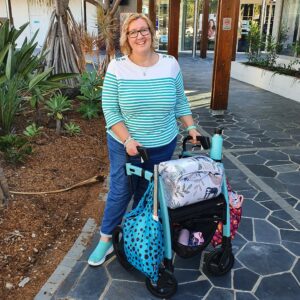
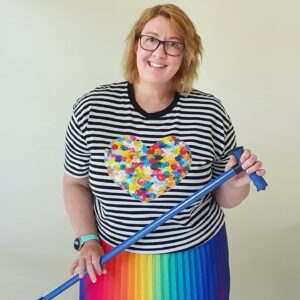
How long have you lived with chronic pain?
I’ve lived with chronic pain every day since I was 15 years old. As a teenager I experienced constant headaches and migraines which, due to medical gaslighting at the time, were never treated correctly and my migraines were simply put down as tension headaches. Over the years I’ve had a lot of back and neck pain, and the headaches have never disappeared. I was officially diagnosed with Fibromyalgia, which is a chronic pain and chronic fatigue condition, around 7 years ago but have most likely lived with it for most of my life, but it has become a lot worse over the past 5 years.
“As a teenager I experienced constant headaches and migraines which, due to medical gaslighting at the time, were never treated correctly and my migraines were simply put down as tension headaches”
How much of your day is impacted by pain?
All day every day is impacted by pain. Each day is different of the pain scale, but I always wake up in pain, and the severity of the pain will depend on whether I can get things done on that day or end up spending the day in bed.
How do you manage your pain levels to be able to participate in your every day life?
Medication only just takes the edge off of my pain levels, the rest comes down to pacing myself when I do various things, using heat packs, lying on an acupressure mat twice a day, and doing what I can on my good days and allowing myself to rest on the not so good days.
Are there things about you that people misunderstand because of your disability, or that people misunderstand about those living with chronic pain?
Many people don’t understand how chronic pain levels can vary from day to day or even hour to hour. They see you out one day and can’t understand why you need to rest in bed for a day or two afterwards because of the pain and fatigue from going out for a short time. I use my social media accounts to help educate what dynamic disability can look like and why I use different mobility aids for different days.
“I use my social media accounts to help educate what dynamic disability can look like and why I use different mobility aids for different days.”
What do you do with yourself? and has this been influenced by your disability?
As I can no longer sit for longer than an hour at a computer or desk due to pain, I gave up working around 3 years ago. I still make hand stamped jewellery on occasions which I sell online. In the past 2-3 years I have become a content creator on Instagram, sharing images and stories about disability or fun fashion, or sometimes both.
I have recently signed with an inclusive talent agency and through this I will be a model for photographic and video content for advertising and marketing. This will be a great way to increase diversity in advertising and showcase disability visibility.
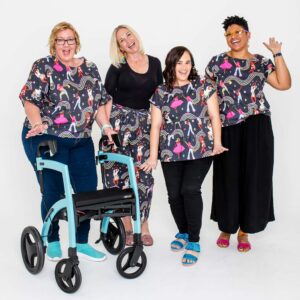
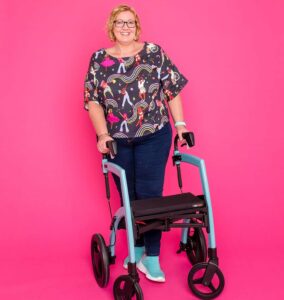
You are a brand ambassador for various fashion retailers, why is this representation important to you?
Being a brand ambassador for fashion brands as a disabled mobility aid user is so important to me because there is not enough disability representation in the media and marketing. When I first needed to start using a walking stick, I was embarrassed because so many people only believe that “old people” use walking sticks. I want to show others that mobility aids are not something to be embarrassed about, and that anyone can become disabled at any age, and this does not stop us wanting to wear fashionable clothes.
” I was embarrassed because so many people only believe that “old people” use walking sticks.”
What is one thing, experience or person you have had that completely changed your life?
When I started using a walking stick, I was so embarrassed and had to deal with random people asking me questions about it. Soon after, I had some psychology sessions where I discussed these issues that I was having. I worked through this and it helped me to let go of any internalised ableism I have, and these sessions also helped me to embrace my disability and my mobility aids, and I also had a major shift in my clothes too, as I went from wearing all black and denim to wearing all the colour and dresses! It was a major change of thinking and this has changed my life.
You are an advocate for the use of aids and equipment at any age to support being active and independent. Of your mobility aids, is there one that has made the most difference in your life? Why?
Each of my mobility aids have made a massive difference in my life through my different stages of disability. Around 6 years ago started using a walking stick to help keep my balance when I walked. I started off with my late grandmother’s black walking stick which was adjustable with a wooden handle. It made a really clunking sound every time it hit the ground, so I needed to find a replacement. I was told that I should get another black walking stick so that it would “blend into the background”, but I had already experienced that this would not be the case, as I would have random strangers come up and ask me what was wrong with my knee/leg and why was I using a cane. This happened A LOT, and as I was still coming to terms with needing to use a walking stick myself, I would just tell people that “my body hates me”.

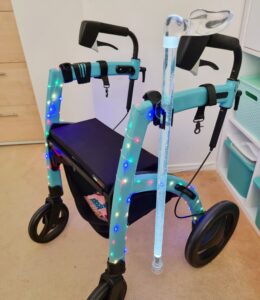
“I was told that I should get another black walking stick so that it would “blend into the background”
When I bought a replacement stick, I just got a blue sparkly one from the chemist. It was adjustable and it did the job. Then I found some amazing walking sticks available online, so for my next birthday I asked for a NeoWalk walking stick in my favourite colour – Tiffany Blue. It was made to measure and had a gorgeous clear acrylic ergonomic handle – this stick felt more like me. The following Christmas, I needed to add another accessory, I mean walking stick to my collection, so I asked for another NeoWalk stick, this time it was a clear stick with glitter through it which can also light up. Her name is Starry Skye and she is my ‘going out’ stick.
Now with my fun walking sticks, I didn’t feel embarrassed for using them, as they looked amazing and did not look clinical like most walking sticks do. So when it came to choosing a rollator/wheelie walker, I went back to Instagram for inspiration to see what rollators were being used by disabled women under 50 that had a fun edge to them.
I found the Rollz Motion rollator, and as soon as I saw that it came in a turquoise blue colour, I knew this was the one for me. Again, finding a mobility aid that matches my outfits like an accessory helped with any internalised ableism I had, which then made me feel more comfortable and confident when using them. When I started using my Rollz rollator/wheelie walker 4 years ago, this allowed me to walk further and for a bit longer as I was more stable, plus it doubles as a seat and also as my own personalised shopping trolley! When I knew that I would be needing a wheelchair down the track, I again started researching online and I really liked the look of the Whill C2, as well as it’s features. When I asked my OT what their recommendation would be for either a power wheelchair or a scooter, they also recommended the Whill for me to use.
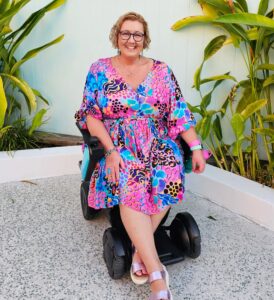
Then when I started using my power wheelchair 1 year ago, this gave me the ultimate sense of freedom, as my mobility had declined over the years and I was struggling to walk 200 metres, but using my wheelchair enabled me to go out with my family and to even travel. Once I got the Whill, I felt it was a bit all too black, so I added some holographic vinyl to the sides of it to personalize and again make it more me. By personalizing my mobility aids and treating them like accessories to my outfits, not only has it helped me to be more confident in using them, but now instead of people coming up and asking me what is wrong with me, they now comment on how fun or cool my mobility aid is, and it helps to show that using mobility aids is not something to be embarrassed about, and that they can give you your freedom back when your mobility is limited.
“..using mobility aids is not something to be embarrassed about, and that they can give you your freedom back when your mobility is limited.”
What are your favourite things to do? And how has your disability impacted on the way you participate in these things?
I’ve always loved travelling to various places around Australia, and after I got my power wheelchair last year, my family and I went on our very first overseas holiday.
As I am still able to walk very short distances, we did go to some places like Santorini which are not very accessible, but was a bucket list destination that I wanted to go to.
But booking our accommodation now as a wheelchair user took a lot more research, and we used Google maps a lot to virtually visit the places we were going to see if it was easy for us to get from the train station to the hotel, or were there dropped kerbs near where we were staying to be able to get around easily.
We found that many places we visited offered free entry for wheelchair users, or heavily discounted prices, plus the option to skip the queues with wheelchair access. Some things I could not access so I had to kiss out on those, but we made the most of our trip with what I could do.
Travelling as a wheelchair user takes so much planning but it is definitely worth it.
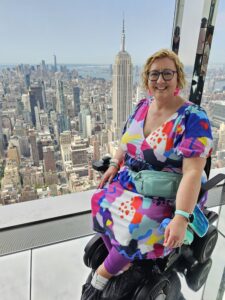

“Travelling as a wheelchair user takes so much planning but it is definitely worth it”
Knowing what you know now, what advice would you give your 18-year-old self?
You can do hard things!
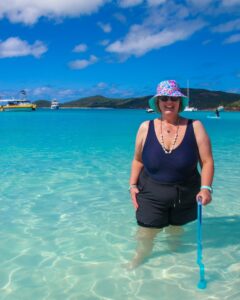
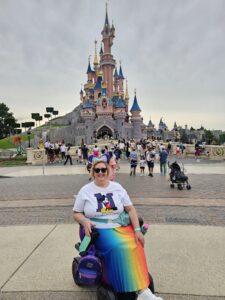
Is there something that you would like people to know about you or about people with disability that they might not know?
Not all disabilities are visible, and you never know the pain that people may be going through when doing basic day to day things.
“Not all disabilities are visible, and you never know the pain that people may be going through when doing basic day to day things”
Best advice that you would like to share with other women with disabilities?
Find a doctor who understands you and your needs, same goes for friends too! Go easy on yourself and don’t push yourself to your limits because you are trying to everything for everyone else – put yourself first and rest when you need.
Do you have a way for people to connect or follow you that you would like me to share?
You can follow me on Instagram @michellepownell

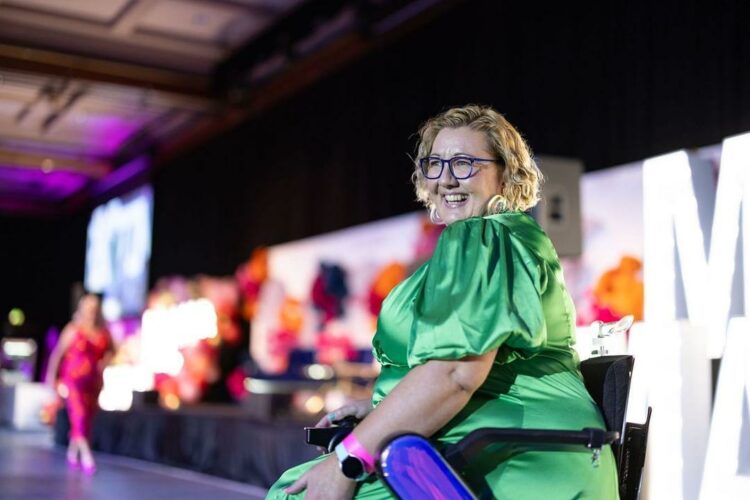


Greetings. I am on the search for information and hopefully the purchase of the XSTO M4 mobility chair.
I am a resident of Auckland, New Zealand and, to my knowledge, there is no distributor in this country. Help!
Happy 2025
Thankyou for your message Gerard, i am not able to recommend a supplier for this chair in NZ however you may want to contact distributors in Australia and query how they may get something to you in NZ? best of luck to you – https://www.bettermobility.au/mobility-scooter-step2/ thanks, chris